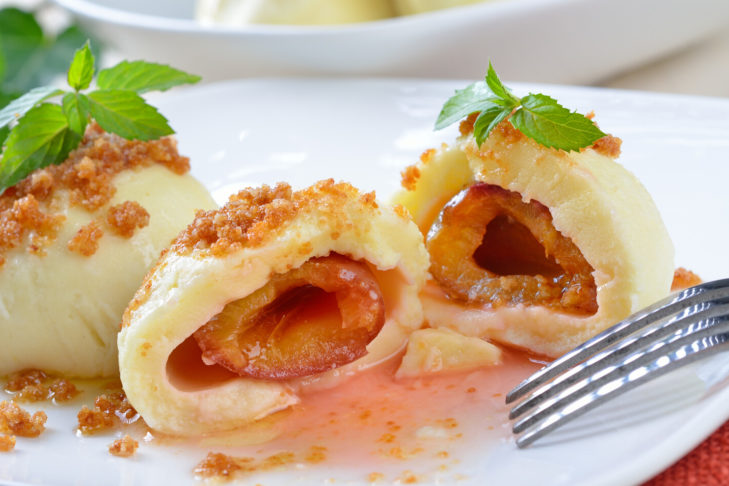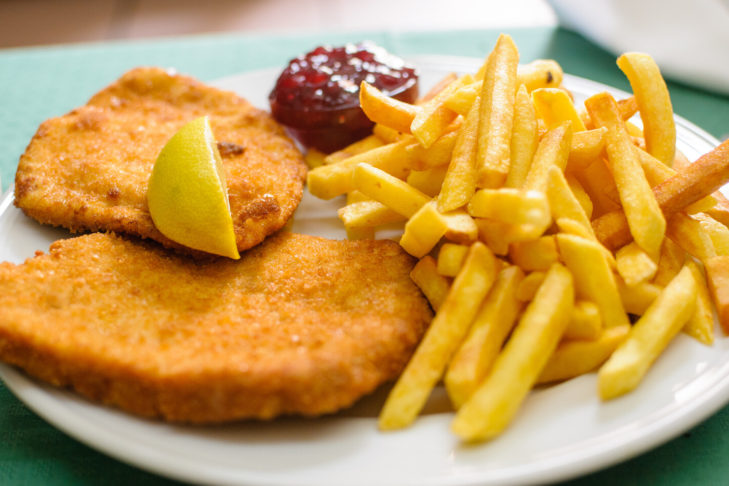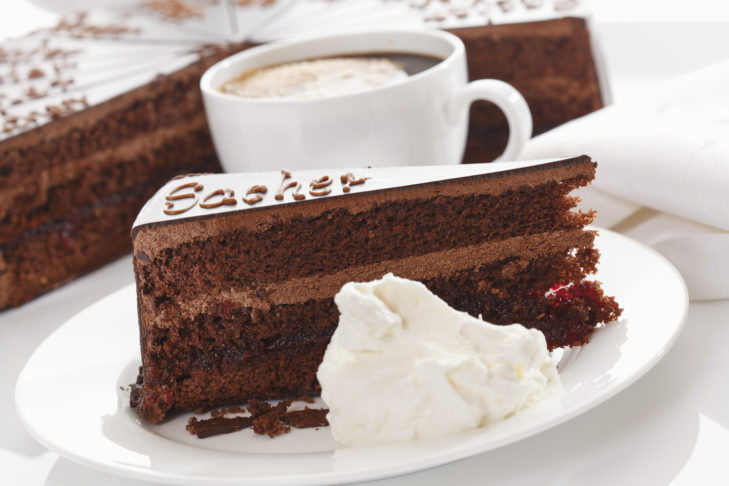Whether it’s main courses or desserts – Austria has plenty to offer winter sports fans with a sweet tooth. SnowTrex has typical Austrian recipes at the ready – from yeast dumplings to Kasnockn and fried trout. Enjoy your meal!
Yeast dumplings
These large, fluffy, hemispherical dumplings with their delicious plum jam filling, topped with a warm vanilla sauce and garnished with fine poppy seed sugar are reminiscent of grandma’s good cooking.
Ingredients: 15 g fresh yeast, 2 sachets of vanilla sugar, 100 ml lukewarm milk, 250 g flour, salt, 1 egg, 80 g plum jam (Austrian Powidl), ½ organic orange, 100 g butter, 50 g poppy seeds or ground poppy seeds.
Steps to make: Firstly, crumble the yeast in a bowl. add 1 teaspoon of vanilla sugar and the milk. Mix the flour, a pinch of salt and the remaining vanilla sugar in another bowl. Now add the yeast milk and the egg and knead everything into a smooth dough using the dough hook. Cover with a cloth and leave in a warm place for about 1 hour.
Now divide the dough into eighths and shape each piece into a ball, then press flat and spread with a little plum purée. Fold the dough over the jam and carefully shape it into a dumpling. Cover the dumplings again for 15 minutes.
Bring 2 litres of water to the boil in a large pan, add a little salt and place the dumplings in the water over a low heat. Cover and leave to cook for about 20 minutes. During this time, the lid must not be removed and the water must not boil, otherwise the dumplings may burst.
In the meantime, wash half the orange in hot water, finely grate the zest and squeeze out the juice.
Melt the butter in a pan and brown lightly. Stir in the poppy seeds and toast the poppy seed and butter mixture over a low heat while stirring. Add the orange zest and 1 tbsp of juice.
Remove the dumplings from the water with a slotted spoon and brush with the poppy seed butter.
Kasnockn
Kasnockn are considered the national dish of Vorarlberg. They are also known as “Knöpfle” or “Kässpätzle”. The basic recipe is a dumpling dough, an indispensable part of Austrian home cooking.
Ingredients: ¼ kg flour, salt, 1 egg, approx. ¼ litre water, 200g grated mountain cheese, 2 onions, 3 tbsp lard or oil, 5 tbsp butter.
Steps to make: Prepare a semi-firm dough from the flour, salt and egg, which pulls off the spoon (do not work it too firmly, otherwise the dough will become sticky). Press the dough through a sieve into boiling water and cook just until the spaetzle rise; strain and rinse with cold water.
Place the spaetzle alternately with grated cheese in a preheated bowl; the last layer must consist of cheese.
Chop the onions, fry in lard until golden brown and pour over the spaetzle. Finally, pour over the browned butter.
Semolina dumpling soup
Beef soup is the clear soup par excellence and is very popular as the basis for many Austrian soup specialities. To achieve a good soup, you only need a few simple steps and a little time to prepare it.
Ingredients: 600 g beef, 1 ½ – 2 litres of water, 1 small bunch of soup greens (carrots, yellow turnips, celery, leek, parsley greens), 1 onion, 8 peppercorns, 3-4 threads of saffron, chopped chives, 80 g coarse semolina, 30 g butter, 1 egg, salt, nutmeg.
Steps to make: Wash the beef bones very well with warm water, place in cold water and boil for a few minutes. Then strain and rinse in cold water. Place the meat with the bones, greens, onion and spices in plenty of water, cover and cook slowly for 2-3 hours. Make sure that the soup does not boil too much, otherwise it will become cloudy. Then strain the soup, season to taste and refine with chives.
For the semolina dumplings, mix the butter with the egg, salt and a hint of nutmeg. Add the semolina, mix well and leave to rest for 5 minutes. Cut out dumplings of any size, add to the boiling soup and leave to stand for approx. 15 minutes.
Wiener schnitzel
A real Wiener schnitzel must always be a veal schnitzel. And even if the breadcrumbs are no longer made of gold leaf, as they once were in Constantinople and Milan, the schnitzel still has to be golden-brown and shiny.
Ingredients: 4 veal escalopes, salt, flour, 1 egg, 2 tbsp milk or water, breadcrumbs, fat for frying.
Steps to make: Pound the meat well, make several cuts around the edges and lightly salt both sides. Turn the cutlets one after the other in flour, the egg mixed with milk and water and breadcrumbs. Press the breadcrumbs down lightly. Heat the fat in a suitable pan (the fat should be at least the height of your thumb) and fry the schnitzels on both sides until golden brown, flipping the pan repeatedly. Drain well and serve garnished with lemon wedges.
Esterházy roast beef
In this case, we owe the roast beef to the famous Esterházy dynasty of magnates, who were not only great patrons of the arts or successful politicians, but also gifted gourmets.
Ingredients: 4 roast patties, salt, pepper, flour, fat, ½ onion, 2 carrots, ½ tumeric, 1 parsley root, approx. 125 ml soup, 1 tsp flour, 125 ml sour cream, 1 lemon.
Steps to make: Pound the roasts, score them slightly around the edges, season with salt and pepper and dip one side in flour. Place the floured side in the heated fat and brown on both sides. Finely slice the onion and root vegetables. Fry the onion strips in the frying fat, then fry the root vegetables briefly. Add the soup to the vegetables, bring to the boil and pour over the roast. Sauté the pieces of meat in the sauce for 15-20 minutes. In the meantime, whisk together the flour and cream to thicken the sauce. Season with finely sliced lemon zest and a dash of lemon juice and cook for a further 5 minutes. Pour the sauce over the roast pieces when serving – the Esterházy roast is ready. Sauté the roots separately in a little butter and spread over the roast when serving.
Roast trout
As an alternative to the meat dishes, there is also a light dish for all sportsmen’s stomachs. Roast trout in the old tradition.
Ingredients: 4 trout, salt, flour, 8 tbsp butter, 8 tbsp chopped herbs (parsley, lemon balm, possibly some tarragon, chervil, sage).
Steps to make: Salt the gutted trout, dredge in flour, place in hot butter and fry on both sides until brown and keep warm.
Heat the finely chopped herbs in a frying pan with a knob of fresh butter. Pour over the trout immediately and serve.
Sacher tart
The Hotel Sacher in Vienna is one of the most famous hotels in the world. No wonder, as it serves one of the most delicious cakes in the world.
Ingredients: 150 g butter, 150 g sugar, 150 g chocolate, 8 eggs, 120 g flour, butter, breadcrumbs, apricot jam, 150 g chocolate, 1 tbsp oil, 200 g sugar, 125 ml water.
Steps to make: Beat the butter with half the sugar, the chocolate softened in a bain-marie and the egg yolks added one at a time until thick and fluffy. Sift the flour over the foamy mixture. Beat the egg whites with the remaining sugar until stiff and pour over the flour. Mix everything together carefully. Pour the mixture into a buttered cake tin sprinkled with breadcrumbs and bake at 180°C for approx. 1 hour.
Turn the cake out onto a wire rack to cool, remove from the tin after approx. 2 hours and place on a plate so that the smooth cake base is on top. Spread a very thin layer of apricot jam on top and cover with chocolate icing. The Sacher Torte tastes particularly delicious served with whipped cream!
To make the chocolate icing, melt the chocolate in a bain-marie and mix with the oil. Bring the sugar and water to the boil. Stir the cooled sugar solution into the melted chocolate by the spoonful until smooth.
Marble bundt cake
Marmorgugelhupf belongs on the Austrian coffee table like no other cake.
Ingredients: 150 g butter, 120 g sugar, 1 sachet vanilla sugar, 4 eggs, 4 tbsp cream, 250 g flour, ½ sachet baking powder, 2 tbsp cocoa, butter, breadcrumbs.
Steps to make: Separate the eggs. Cream the butter, ⅔ of the sugar, vanilla sugar and egg yolks. Mix in the cream. Mix the flour and baking powder and sift over the foam mixture. Beat the remaining sugar with the egg whites until stiff and also pour over the foam mixture. Mix everything carefully.
Divide the dough into two halves. Mix the cocoa with a little water and carefully mix into one half of the dough.
Pour the dark and light mixture alternately into a buttered bundt tin sprinkled with breadcrumbs. Finally, use the handle of a wooden spoon to pull through the two dough mixtures a few times to create streaks. Bake the cake at 180°C for approx. 1 hour.
Salzburg dumplings
After a long day in the snow in Salzburger Land, there is nothing better than starting the evening with a typical speciality.
Ingredients: 4 eggs, 60 g sugar, 20 g flour, 4 tbsp butter.
Steps to make: For the Salzburger Nockerln, separate the eggs, beat the egg whites until stiff, add the sugar a spoonful at a time and beat until the egg whites are glossy and firm to the touch. Whisk the egg yolks and carefully fold into the egg whites. Sprinkle over the flour and carefully fold in.
Melt the butter in an oval, ovenproof dish. Spread the meringue in the form of three large heaps (“dumplings”) and bake at 200°C for 5-10 minutes. Sprinkle with sugar and serve immediately.
Apple strudel
According to legend, the strudel comes from baklava dough. And baklava is a typical Turkish dessert. According to writings, the strudel probably originated in Arabia, from where it was brought to Turkey via Egypt, Palestine and Syria. Turkish baklava probably reached us via the Balkans after the conquest of Byzantium in 1453 – as marching rations.
Ingredients: ¼ kg finest flour, 1 tsp salt, 1-2 tbsp oil, approx. 125 ml lukewarm water, 100 g breadcrumbs, 125 g butter, 1 ½ – 2 kg apples, sugar, cinnamon, clove powder, nuts and sultanas.
Steps to make: To make the strudel dough, mix together the flour, salt, oil and enough lukewarm water to make a soft dough. Knead very well until it becomes silky smooth.
Shape the dough into a loaf, cover and leave to rest for approx. 30 minutes. Roll out the dough on a floured table and stretch it out with the back of your hand until it is wafer-thin. Cut off the edges.
Fry the breadcrumbs in a knob of butter until golden brown. Spread over the buttered strudel dough. Peel the apples, cut into thin slices or grate coarsely, season with sugar, cinnamon and a pinch of clove powder and spread over the breadcrumbs. Sprinkle with a few sultanas and/or coarsely grated nuts to taste. Brush the rolled strudel with plenty of butter, place seam-side down on a baking tray and bake at 180°C until golden brown.
Boiled beef
Who doesn’t know the feeling: you’ve been skiing and doing sport all day and then in the evening you just want one thing: something to eat that fills you up and tastes good. In such a case, the “Tafelspitz” is one of the recommended dishes.
Ingredients: approx. 2 kg of boiled beef (end of the beef tail) and 3 kg of leg meat, 300 g of root vegetables (carrots, yellow turnips, celery in equal parts) peeled and cleaned, 1 onion with skin, halved ½ stalk of leek cleaned, 10 black peppercorns, salt, some lovage, 6 slices of marrow bone, chives for sprinkling.
Steps to make: Fry the unpeeled onion in a pan without fat until dark brown on the cut sides and set aside. Wash the marrow bones and meat while warm and drain well. Bring about 3 litres of water to the boil, add the meat and cook at a gentle simmer for 3-4 hours. Always skim off any foam and cloudy matter that rises to the surface. Add the peppercorns, onion halves and lovage and add the root vegetables and leek about 30 minutes before the end of cooking. Remove the meat from the soup, strain the soup and season with salt. Add the marrow bones and leave to simmer for a further 5 minutes. Cut the meat against the grain into finger-thick slices, slice the root vegetables and bring to the boil again in a suitable casserole dish with some of the soup, the marrow bones, root vegetables and leek. Sprinkle with chopped chives for a refined flavour.
Wachau apricot dumplings
Traditionally, apricot dumplings can be made with potato dough, choux pastry or curd cheese dough. We will concentrate on the curd cheese dough.
Ingredients: 400 g curd cheese, 150 g flour, 2 eggs, a pinch of salt, a little sour cream, approx. 1 kg apricots, sugar cubes, 6 tbsp breadcrumbs, butter.
Steps to make: Crumble the flour and curd cheese, mix in the eggs and salt. If the dough is too firm, add a little more cream. Chill before use. Wash and dry the apricots. Remove the stone with the handle of a wooden spoon and fill the fruit with a lump of sugar cube instead of the stone. Shape the dough into a roll about 5 cm thick, cut into slices and flatten each slice. Place an apricot in each slice, cover with dough and form dumplings.
Place the dumplings in boiling salted water, cook gently for 15-20 minutes, drain well and coat in golden brown breadcrumbs. Serve sprinkled with icing sugar.
Styrian root meat
Styria is also known as the “Green Marrow” because of its extensive forest areas. In culinary terms, Styria is also famous for its wines and Styrian root meat.
Ingredients: ¾ kg pork (shoulder, belly meat), 1 litre water, 125 ml vinegar, 1 bay leaf, 8 peppercorns, 6 spice grains, 6 juniper berries, 3 garlic cloves, salt, 2-3 carrots, 1 yellow turnip, ½ cellar bulb.
Steps to make: Tie the spices in a linen bag, peel the roots and cut into fine strips, slice the onions in half. boil 1 litre of water with vinegar and all the seasoning ingredients, add the pork so that it is covered with water and cook for 45 minutes. Shortly before the end of cooking, add the roots and onions and cook together until soft. Remove the spice bag, cut the meat into finger-thick slices and arrange the root vegetables and onion slices decoratively on top. Finish with a few spoonfuls of the cooking stock and serve garnished with chives.
Tyrolean dumplings
The dumpling is something of a figurehead of rural cuisine. Depending on tradition and economic structures, you can find all kinds of them in the various Austrian regions: flour dumplings, bread dumplings, potato dumplings and also bread dumplings.
Ingredients: 6 stale bread rolls, 250 ml milk, 3 eggs, salt, 1 small onion, 1 tbsp parsley, 200 g smoked meat, 2 tbsp butter, 2-3 tbsp flour
Steps to make: Whisk the milk, eggs and salt and pour over the diced bread rolls. Sauté the finely chopped onion, chopped parsley and finely chopped smoked meat in butter and mix with the breadcrumb mixture. leave to stand for 30 minutes and then mould into a firm dumpling dough with the required amount of flour. Moisten your hands with water and form medium-sized dumplings. Place them in boiling salted water and leave to stand for 15-20 minutes.
Cabbage strudel
When we talk about strudel, many people probably think of sweet strudel first. But savoury strudels, such as cabbage strudel, are also a must-try. It is not for nothing that it is so popular in Burgenland.
Ingredients: ¼ kg finest flour, 1 tsp salt, 1-2 tbsp oil, approx. 125 ml lukewarm water, 1 large head of cabbage, 1 onion, 2 tbsp sour cream or oil, ½ tsp sugar, 1 tbsp vinegar, ¼ – ½ litre beef stock or water, salt, pepper, 2 tbsp butter or lard
Steps to make: To make the strudel dough, mix together the flour, salt, oil and enough lukewarm water to make a soft dough and knead very well until silky smooth. Shape the dough into a loaf, cover and leave to rest for approx. 30 minutes. Roll out the dough on a medium-sized table covered with a floured cloth and stretch it out with the back of your hand until it is wafer-thin. Cut off the edges.
Remove the stalk from the cabbage and cut into thin strips. Brown the chopped onion with the sugar in the fat. Add the cabbage and sauté. Deglaze with vinegar, season with salt and pour in the soup. Sauté the cabbage slowly. If necessary, add a little more liquid. Flavour the finished cabbage with salt, pepper and vinegar and leave on the cooker until the liquid has evaporated. Brush the strudel dough with melted lard or butter. Spread the cabbage on top. Roll up the strudel, place seam side down on the baking tray and bake at 180 °C until golden brown. Garnish with caraway seeds sprinkled over the strudel as desired.
Schlipfkrapfen
Schlipfkrapfen are often served in various restaurants in ski resorts to recharge your batteries after skiing. Here is the recipe for you to make at home as a souvenir of your skiing holiday.
Ingredients: 300 g flour (half rye flour, half wheat flour), salt, 1 egg, water as required
Spinach filling: ½ kg spinach, 1 tbsp butter, salt, pepper, nutmeg, breadcrumbs Meat filling: 1 onion, 2 tbsp butter, 400 g meat (boiled or roasted), 1 egg, parsley, salt, marjoram, pepper, 1-2 tbsp breadcrumbs
Steps to make: Mix the flour, salt and egg with the required amount of lukewarm water to make a pasta dough; knead very well and leave to rest for 30 minutes.
Shape the dough into a thicker roll, cut into thin discs and roll out each disc to the size of the palm of your hand. Cover with filling, fold in half and press the edges firmly. Boil the doughnuts in salted water for approx. 10 minutes, lift out and place in layers in a bowl. Each layer should be sprinkled with grated cheese, then season with hot fat.
Szeged goulash
Szeged goulash does not originate from the Hungarian town of Széged, as the name might suggest, but goes back to the Szeklers, the Hungarian inhabitants of Transylvania. It was therefore originally called Székelygulyas.
Ingredients: ½ kg fatty pork, 150 g smoked bacon, 3 onions, 1 tbsp paprika powder, salt, caraway seeds, 1 clove of garlic, 125 ml water, ½ kg sauerkraut, 125 ml sour cream, 1 tsp flour
Steps to make: Cut the meat into 2-3 cm pieces. Cut the bacon into cubes and heat in a pan until translucent. Add the chopped onion, fry until light brown, add the paprika and meat and fry briefly. Season the goulash with salt, caraway and garlic, pour in water, cover and simmer for 15 minutes. Add the sauerkraut, cut a few times, to the pan, cover and simmer until soft. Before serving, whisk the flour and cream together well, stir into the goulash and bring to the boil again briefly.
Enjoy your meal!








